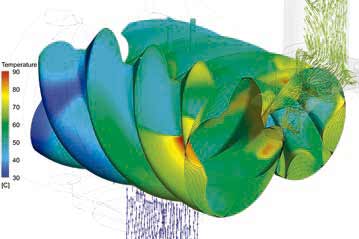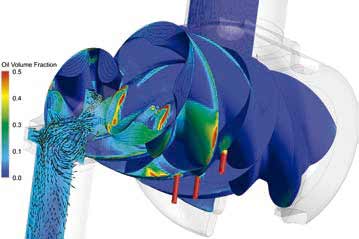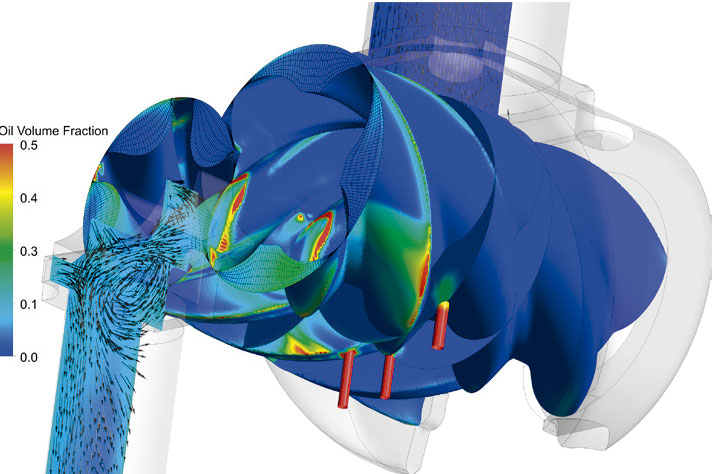BRITISH SOFTWARE COMPANY CAN SAVE INDUSTRY GIGAWATTS OF ENERGY
A British university spin-out company has perfected mechanical analysis software that improves the efficiency of compressors and pumps with the potential to save almost 1% of energy costs used for compression.
 The market-leading software – called SCORG – developed by PDM Analysis Ltd, a spin-out of City, University of London, performs computational fluid dynamics (CFD) modelling in screw compressors, expanders and pumps that are used in many industrial applications including refrigeration and air conditioning. The data from SCORG allows compressor manufacturers to design more efficient machines and run them more efficiently.
The market-leading software – called SCORG – developed by PDM Analysis Ltd, a spin-out of City, University of London, performs computational fluid dynamics (CFD) modelling in screw compressors, expanders and pumps that are used in many industrial applications including refrigeration and air conditioning. The data from SCORG allows compressor manufacturers to design more efficient machines and run them more efficiently.
The result of a 22-year journey, SCORG has proven to increase the performance – lowering both energy consumption and carbon emissions – of these compressors by up to six percent, a huge improvement for already efficient industrial machinery.
Refrigeration and air conditioning alone forms about 25% of total energy usage in the United States during the summer months, and compressors are found in all refrigeration and AC devices. Using SCORG on refrigeration and air-conditioning compression alone and reducing their energy consumption by up to 6%, can lead to a potential saving of at least 1.5% of US total energy consumption.
This does not include the energy reduction in other big applications like oil and gas and steam power, or the adoption of this technology in the screw expander, gear pump and motors industry, meaning the true potential for energy and CO2 saving is much higher. “Pressure and temperature increase in screw compressors are caused by the reduction of volume trapped in the machine,” says Professor Ahmed Kovacevic, Director of PDM Analysis Ltd. “In a screw compressor these volumes are of rather complex shape, formed by the rotors and the casing“.
 The software works by accurately analysing property changes of the fluid within that complexly shaped volume, using CFD modelling specially modified by PDM Analysis Ltd. SCORG divides the complex chamber volume into small cells using a numerical grid devised by Professor Ahmed Kovacevic, whose PhD at City in 2002 pioneered this gamechanging technique.
The software works by accurately analysing property changes of the fluid within that complexly shaped volume, using CFD modelling specially modified by PDM Analysis Ltd. SCORG divides the complex chamber volume into small cells using a numerical grid devised by Professor Ahmed Kovacevic, whose PhD at City in 2002 pioneered this gamechanging technique.
He adds, “The main obstacle in using CFD to be able to see inside these machines was the lack of a reliable method to produce a numerical grid needed for successful CFD.” Kovacevic and his team’s research over 20-years has produced a reliable, industry-accredited method, leading to SCORG. More recently, SCORG version 5.7 is also enabled to analyse thermal expansions and change in clearances of these machines, essential for their reliable performance and energy efficiency.
The first SCORG licensee was Ingersoll Rand from US. The software is now adopted by all the Japanese major screw compressor manufacturers, several US companies including Gardner Denver and has a growing footprint in Europe, China and India.
“Notably, with the use of SCORG, we were able for the first time to model a screw compressor in high fidelity using computational fluid dynamics (CFD) which provided new and unique insights into the internal workings of our products that are incredibly difficult, if not impossible, to realise through experimentation alone.” says Donald Lawson, R&D Manager in Howden Compressors, the global supplier of reliable screw machines.
Global market potential
“There are up to 700 compressor companies in the world and currently we serve about 200. The potential to increase the efficiency of millions of machines is great and very exciting.” says Kovacevic.
The global market for screw compressors is predicted to be worth $11 billion p/a by 2021 with compound growth of 6.62% (https://www.marketsandmarkets. com/Market-Reports/screw-compressor- market-122896617.html). Compressors of all types represent about 17 per cent of energy use in developed countries, producing over 3,000 mega tonnes of CO2 per year. Energy costs from compressors are about Eu275 billion pe annum.
“With our software companies can improve their operating efficiencies by four, five, up to six per cent – this is a huge improvement for machines that are already very efficient,” says Kovacevic.

